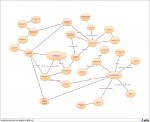These were our rules:
[sblock]
Setting Up, and What's a TRAP?
There are three "pages" (we're using a digital tabletop) - the Web, the Codex, and the Map. We'll be doing brainstorming on these 3 pages, making up a world. We'll make this world out of building blocks of Situations - interactive elements that can come out in play. These building blocks are called TRAPs.
When we say TRAP we mean Threat, Reward, Asset, or Problem. They're the elemental parts of the game's Situation - after all, the game's about defeating Threats and solving Problems by using your Assets, and earning Rewards for doing so. Practically everything interesting in a fantasy world outside of the protagonists is a TRAP. In Lord of the Rings, Mordor is a Threat, being knighted is a Reward, the city of Rivendell is an Asset, and Theoden's curse is a Problem. Nazgul are Threats, and a belly full of beer is a Reward, Elven archers are Assets, the draw of the ring is a Problem. You can read more about what TRAPs are and some very down-to-earth examples here:
http://www.enworld.org/showthread.php?t=192201
Everybody gets 30 Coins. Decide who goes first however you wish. If you are playing online you should make a list of the turn order and stick to it for the game.
On your turn
1. If there are any coins in the pot, you can award a Coin to a player if you thought they had a cool idea. This is used to encourage the ideas that are most exciting to you.
2. You can propose a TRAP or pass. When you propose it, you need to spend 2 Coins and get 2 other players to spend 1 Coin each. Anyone can veto that idea but if they do you all keep your Coins. If the TRAP you propose gets the support and doesn't get vetoed, then we write the title on the Map, Web, or Codex (as appropriate).
The first ones are often quite general, like Desert Winds (P), Snow (P), Citadel of the Moon (R), Knights of Death (T), Demons (T), or Valley of Gold (A). After the name of the TRAP they put a letter indicating what kind of TRAP it is for future reference.
a. Add a TRAP to The Web. Usually you will draw a line from one or more words already in The Web, and write a related word at the end of that line. For example, if you already had "Akagon, home sweet home (R)" on the map, you could write "Greedy, Dangerous House Muasi (T)". If House Muasi is trying to steal from the people of Akagon, then you would draw a line between them.
b. Add a TRAP to The Codex. This is a new phrase about the world that doesn't fit on the web or map, like "Elves are claustrophobic. (P)"
c. Add a TRAP to The Map. Indicate where your TRAP is, such as "Leviathan (T)" and a dangerous-looking X mark next to it.
The stuff that goes on the Codex or Map has to relate to something on the Web. Stuff on the Web doesn't have to relate to other stuff on the Web but has to relate to something on the Codex or the Map. So we can't silo - the ideas have to relate to each other. That was probably how you guys would go about it anyway but it needs to be clear.
This is the idea: TRAPs go in the most appropriate page. If it's a place, or highly tied to location (like a monster chained under a mountain) it goes on the
Map. If it's part of the web of factions and NPCs vying for power, it belongs on the
Web. If it's some other statement about the world, it belongs on the
Codex.
Once it's added, it's a Fact. One of the coins spent on this fact goes into a Pot, the others are out of the game.
If you have an idea you want to add, but it's not a TRAP, you can still propose it. You and supporters need to spend double the Coins to put it through, but usually one of your supporters will suggest a way to turn the idea into a TRAP and your idea will still make it in. The best thing is to be bold - don't worrry about the format so much, just say what you think is cool and the players will help make it into something that is part of the game's Situation.
3. When one of your ideas has made it onto a page, or you pass, your turn is over, go to the next player (clockwise if in person).[/sblock]

